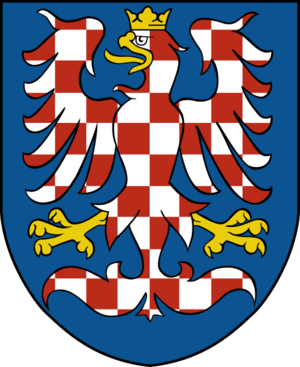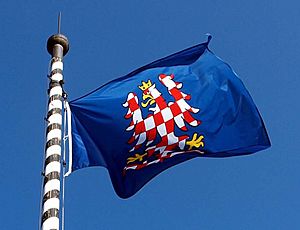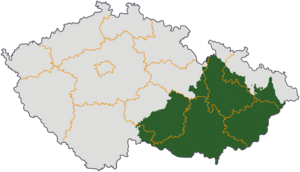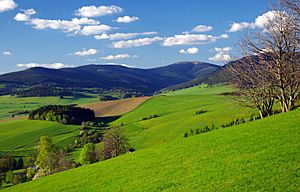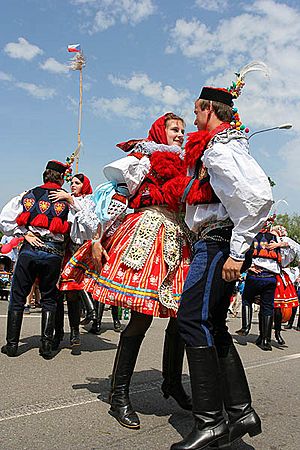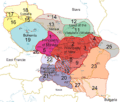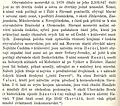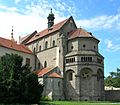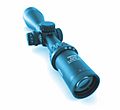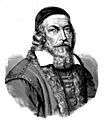Moravia facts for kids
Moravia (in Czech and Slovak: Morava; in German: Mähren) is a historical region in the eastern part of the Czech Republic. It gets its name from the Morava River. This river flows from the north to the south through the land.
Moravia, along with Bohemia in the west and Silesia in the north, used to form the historical Czech Lands. Today, Moravia, Bohemia, and a small part of Silesia make up the modern Czech Republic.
Some of the important cities in Moravia today are Brno, Olomouc, Ostrava, and Zlín.
Exploring Moravia's Geography
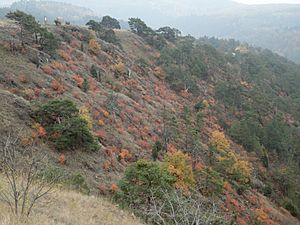
Moravia covers most of the eastern part of the Czech Republic. Its natural shape is strongly influenced by the Morava River basin. Mountains in the west and east also play a big role. Most rivers in Moravia start in these mountains.
How Moravia Connects Central Europe
Moravia has a special location in Central Europe. Most highlands in this part of Europe run from west to east. This makes it hard to travel north or south. But Moravia has a wide, flat area called the westernmost Subcarpathia. This area is about 14 to 40 kilometers (9-25 miles) wide. It sits between the Bohemian Massif and the Outer Western Carpathians.
This flat area provides an easy path between the Danube and Polish regions. This made Moravia very important for large animals moving around. It was also a key route for early human settlements in ancient times.
Moravia's Borders and Neighbors
Moravia shares borders with several places. To the west, it borders Bohemia. To the southwest, it borders Lower Austria. Slovakia is to the southeast. A very short border with Poland is in the north. Finally, Czech Silesia is to the northeast.
Natural features form many of Moravia's borders. The Sudetes mountains are in the north. The Carpathians are in the east. The Bohemian-Moravian Highlands are in the west. The Thaya river flows along the border with Austria. The point where Moravia, Austria, and Slovakia meet is where the Thaya and Morava rivers join. The border with Silesia in the northeast partly follows the Moravice, Oder, and Ostravice rivers.
Between 1782 and 1850, Moravia also included a small part of Austrian Silesia. This happened after Frederick the Great took most of Silesia for Prussia.
Regions Within Moravia Today
Today, Moravia includes several regions of the Czech Republic. These are the South Moravian Region, the Zlín Region, and most of the Olomouc Region. It also covers the southeastern half of the Vysočina Region. Parts of the Moravian-Silesian, Pardubice, and South Bohemian regions are also in Moravia.
Mountains and Valleys of Moravia
Moravia is a transition area between the Bohemian Massif and the Carpathians. It also lies between the Danube basin and the North European Plain. Its main land features are three wide valleys:
- The Dyje-Svratka Valley
- The Upper Morava Valley
- The Lower Morava Valley
These valleys surround the low Central Moravian Carpathians mountains. The highest mountains in Moravia are in the north, in Hrubý Jeseník. The highest peak there is Praděd (1491 meters or 4,892 feet). Other high peaks include Králický Sněžník (1424 meters) and Smrk (1278 meters) in the Moravian-Silesian Beskids. The White Carpathians in the southeast reach up to 970 meters. The Bohemian-Moravian Highlands in the west reach 837 meters.
Moravia's River Systems
Moravia's rivers are very connected. The region's border is much like the watershed of the Morava river. This means almost all of Moravia is drained by the Morava river. The biggest rivers flowing into the Morava are the Thaya (Dyje) from the west and the Bečva from the east. The Morava and Thaya rivers meet at the lowest point of Moravia (148 meters or 486 feet).
Small parts of Moravia's edges belong to other river systems. These include the Elbe, Váh, and especially the Oder in the northeast. The watershed line along Moravia's border is part of the European Watershed. For centuries, people have planned to build a waterway across Moravia. This would connect the Danube and Oder river systems. It would use the natural path through the Moravian Gate.
Moravia's Economy
An area in South Moravia, near Hodonín and Břeclav, is part of the Viennese Basin. This area has a lot of petroleum and lignite (a type of coal). The main economic centers of Moravia are Brno, Olomouc, and Zlín. Ostrava is also important, located right on the Moravian-Silesian border.
Besides farming, Moravia is famous for its viticulture (wine making). It has 94% of the Czech Republic's vineyards. This makes it the heart of the country's wine industry.
-
The oldest iron blast furnace near Brno, built in 1745
Arms Industry in Moravia
Moravia is a major center for the Czech firearm industry. Most Czech firearm makers are located here. Some well-known companies include CZUB, Zbrojovka Brno, Czech Small Arms, Czech Weapons, ZVI, and Great Gun.
Aircraft Industry in Moravia
The Zlín Region is home to several aircraft manufacturers. These include Let Kunovice (also known as Aircraft Industries, a.s.), ZLIN AIRCRAFT a.s. Otrokovice, Evektor-Aerotechnik, and Czech Sport Aircraft. Sport aircraft are also made in Jihlava by Jihlavan Airplanes/Skyleader.
Aircraft production in this region began in the 1930s. In recent years, the industry has shown signs of growing again.
-
The Moravian aircraft Let L-410
Machinery Industry in Moravia
The machinery industry has been very important in Moravia for many decades. This is especially true in South Moravia. Key centers for machinery production include Brno (with companies like Zbrojovka Brno, Zetor, První brněnská strojírna, Siemens), Blansko (ČKD Blansko, Metra), Adamov (ADAST), Kuřim (TOS Kuřim), Boskovice (Minerva, Novibra), and Břeclav (Otis Elevator Company). Many other machinery factories are spread across Moravia.
Electrical Industry in Moravia
The electrical industry in Moravia started in 1918. The biggest centers for electrical production are Brno (VUES, ZPA Brno, EM Brno), Drásov, Frenštát pod Radhoštěm, and Mohelnice (now home to Siemens).
People of Moravia
The Moravians are a Slavic ethnic group. They speak different dialects of Czech, which are often older forms of the language. Before Germans were expelled from Moravia, the Moravian German minority also called themselves "Moravians." Those who were expelled and their families still identify as Moravian.
Some Moravians believe that Moravian is a separate language from Czech. However, most experts and the public do not widely support this idea. Some Moravians see themselves as a distinct ethnic group. But most consider themselves to be ethnically Czech.
In the 1991 census, 1,362,000 people (13.2% of the Czech population) said they were of Moravian nationality. This was the first time people could choose Moravian nationality. In some parts of Moravia, most people identified as Moravians, not Czechs. By the 2001 census, the number of Moravians had dropped to 380,000 (3.7%). However, in the 2011 census, this number rose to 522,474 (4.9% of the Czech population).
Images for kids
-
A map showing the territory of Great Moravia in the 9th century. The map shows the largest area ruled by Svatopluk I.
-
A map showing the growth of the Habsburg territories and Moravia's status within the Habsburg Empire.
-
Comenius, a famous Moravian philosopher and educator.
-
Gregor Mendel, known as the "father of modern genetics."
-
František Palacký, a key figure in the Czech National Revival.
-
Tomáš Garrigue Masaryk, the first President of Czechoslovakia.
-
Leoš Janáček, a famous Moravian composer.
-
Sigmund Freud, the founder of psychoanalysis.
-
Edmund Husserl, a philosopher who founded phenomenology.
-
Alphonse Mucha, a well-known Art Nouveau artist.
-
Adolf Loos, an influential architect.
-
Kurt Gödel, a brilliant logician and mathematician.
-
Emil Zátopek, a famous long-distance runner.
-
Milan Kundera, a celebrated writer.
-
Ivan Lendl, a world-renowned tennis player.
See also
 In Spanish: Moravia para niños
In Spanish: Moravia para niños


